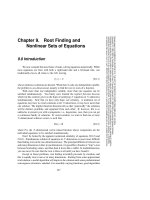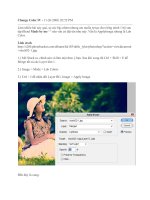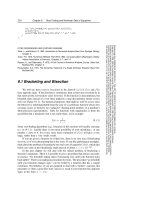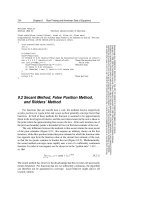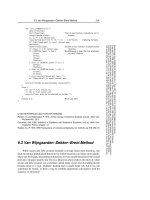Tài liệu Root Finding and Nonlinear Sets of Equations part 3 pptx
Bạn đang xem bản rút gọn của tài liệu. Xem và tải ngay bản đầy đủ của tài liệu tại đây (109.72 KB, 6 trang )
354
Chapter 9. Root Finding and Nonlinear Sets of Equations
Sample page from NUMERICAL RECIPES IN C: THE ART OF SCIENTIFIC COMPUTING (ISBN 0-521-43108-5)
Copyright (C) 1988-1992 by Cambridge University Press.Programs Copyright (C) 1988-1992 by Numerical Recipes Software.
Permission is granted for internet users to make one paper copy for their own personal use. Further reproduction, or any copying of machine-
readable files (including this one) to any servercomputer, is strictly prohibited. To order Numerical Recipes books,diskettes, or CDROMs
visit website or call 1-800-872-7423 (North America only),or send email to (outside North America).
#include <math.h>
#define JMAX 40 Maximum allowed number of bisections.
float rtbis(float (*func)(float), float x1, float x2, float xacc)
Using bisection, find the root of a function
func
known to lie between
x1
and
x2
. The root,
returned as
rtbis
, will be refined until its accuracy is ±
xacc
.
{
void nrerror(char error_text[]);
int j;
float dx,f,fmid,xmid,rtb;
f=(*func)(x1);
fmid=(*func)(x2);
if (f*fmid >= 0.0) nrerror("Root must be bracketed for bisection in rtbis");
rtb = f < 0.0 ? (dx=x2-x1,x1) : (dx=x1-x2,x2); Orient the search so that f>0
lies at x+dx.for (j=1;j<=JMAX;j++) {
fmid=(*func)(xmid=rtb+(dx *= 0.5)); Bisection loop.
if (fmid <= 0.0) rtb=xmid;
if (fabs(dx) < xacc || fmid == 0.0) return rtb;
}
nrerror("Too many bisections in rtbis");
return 0.0; Never get here.
}
9.2 Secant Method, False Position Method,
and Ridders’ Method
For functions that are smooth near a root, the methods known respectively
as false position (or regula falsi)andsecant method generally converge faster than
bisection. In both of these methods the function is assumed to be approximately
linear in the local region of interest, and the next improvement in the root is taken as
the point where the approximating line crosses the axis. After each iteration one of
the previous boundary points is discarded in favor of the latest estimate of the root.
The only difference between the methods is that secant retains the most recent
of the prior estimates (Figure 9.2.1; this requires an arbitrary choice on the first
iteration), whilefalse positionretains that priorestimate for which the functionvalue
has opposite sign from the function value at the current best estimate of the root,
so that the two points continue to bracket the root (Figure 9.2.2). Mathematically,
the secant method converges more rapidly near a root of a sufficiently continuous
function. Its order of convergence can be shown to be the “golden ratio” 1.618 ...,
so that
lim
k→∞
|
k+1
|≈const×|
k
|
1.618
(9.2.1)
The secant method has, however, the disadvantage that the root does not necessarily
remain bracketed. For functions that are not sufficiently continuous, the algorithm
can therefore not be guaranteed to converge: Local behavior might send it off
towards infinity.
9.2 Secant Method, False Position Method, and Ridders’ Method
355
Sample page from NUMERICAL RECIPES IN C: THE ART OF SCIENTIFIC COMPUTING (ISBN 0-521-43108-5)
Copyright (C) 1988-1992 by Cambridge University Press.Programs Copyright (C) 1988-1992 by Numerical Recipes Software.
Permission is granted for internet users to make one paper copy for their own personal use. Further reproduction, or any copying of machine-
readable files (including this one) to any servercomputer, is strictly prohibited. To order Numerical Recipes books,diskettes, or CDROMs
visit website or call 1-800-872-7423 (North America only),or send email to (outside North America).
f(x)
2
3
4
1
x
Figure 9.2.1. Secant method. Extrapolation or interpolation lines (dashed) are drawn through the two
most recently evaluated points, whether or not they bracket the function. The points are numbered in
the order that they are used.
f(x)
x
4
3
2
1
Figure 9.2.2. False position method. Interpolation lines (dashed) are drawn through the most recent
points that bracket the root. In this example, point 1 thus remains “active” for many steps. False position
converges less rapidly than the secant method, but it is more certain.
356
Chapter 9. Root Finding and Nonlinear Sets of Equations
Sample page from NUMERICAL RECIPES IN C: THE ART OF SCIENTIFIC COMPUTING (ISBN 0-521-43108-5)
Copyright (C) 1988-1992 by Cambridge University Press.Programs Copyright (C) 1988-1992 by Numerical Recipes Software.
Permission is granted for internet users to make one paper copy for their own personal use. Further reproduction, or any copying of machine-
readable files (including this one) to any servercomputer, is strictly prohibited. To order Numerical Recipes books,diskettes, or CDROMs
visit website or call 1-800-872-7423 (North America only),or send email to (outside North America).
2
f(x)
134
x
Figure 9.2.3. Example where both the secant and false position methods will take many iterations to
arrive at the true root. This function would be difficult for many other root-finding methods.
False position, since it sometimes keeps an older rather than newer function
evaluation, has a lower order of convergence. Since the newer function value will
sometimes be kept, the method is often superlinear, but estimation of its exact order
is not so easy.
Here are sample implementations of these two related methods. While these
methods are standard textbook fare, Ridders’ method, described below, or Brent’s
method, in the next section, are almost always better choices. Figure 9.2.3 shows the
behavior of secant and false-position methods in a difficult situation.
#include <math.h>
#define MAXIT 30 Set to the maximum allowed number of iterations.
float rtflsp(float (*func)(float), float x1, float x2, float xacc)
Using the false position method, find the root of a function
func
known to lie between
x1
and
x2
. The root, returned as
rtflsp
, is refined until its accuracy is ±
xacc
.
{
void nrerror(char error_text[]);
int j;
float fl,fh,xl,xh,swap,dx,del,f,rtf;
fl=(*func)(x1);
fh=(*func)(x2); Be sure the interval brackets a root.
if (fl*fh > 0.0) nrerror("Root must be bracketed in rtflsp");
if (fl < 0.0) { Identify the limits so that xl corresponds to the low
side.xl=x1;
xh=x2;
} else {
xl=x2;
xh=x1;
swap=fl;
9.2 Secant Method, False Position Method, and Ridders’ Method
357
Sample page from NUMERICAL RECIPES IN C: THE ART OF SCIENTIFIC COMPUTING (ISBN 0-521-43108-5)
Copyright (C) 1988-1992 by Cambridge University Press.Programs Copyright (C) 1988-1992 by Numerical Recipes Software.
Permission is granted for internet users to make one paper copy for their own personal use. Further reproduction, or any copying of machine-
readable files (including this one) to any servercomputer, is strictly prohibited. To order Numerical Recipes books,diskettes, or CDROMs
visit website or call 1-800-872-7423 (North America only),or send email to (outside North America).
fl=fh;
fh=swap;
}
dx=xh-xl;
for (j=1;j<=MAXIT;j++) { False position loop.
rtf=xl+dx*fl/(fl-fh); Increment with respect to latest value.
f=(*func)(rtf);
if (f < 0.0) { Replace appropriate limit.
del=xl-rtf;
xl=rtf;
fl=f;
} else {
del=xh-rtf;
xh=rtf;
fh=f;
}
dx=xh-xl;
if (fabs(del) < xacc || f == 0.0) return rtf; Convergence.
}
nrerror("Maximum number of iterations exceeded in rtflsp");
return 0.0; Never get here.
}
#include <math.h>
#define MAXIT 30 Maximum allowed number of iterations.
float rtsec(float (*func)(float), float x1, float x2, float xacc)
Using the secant method, find the root of a function
func
thought to lie between
x1
and
x2
.
The root, returned as
rtsec
, is refined until its accuracy is ±
xacc
.
{
void nrerror(char error_text[]);
int j;
float fl,f,dx,swap,xl,rts;
fl=(*func)(x1);
f=(*func)(x2);
if (fabs(fl) < fabs(f)) { Pick the bound with the smaller function value as
the most recent guess.rts=x1;
xl=x2;
swap=fl;
fl=f;
f=swap;
} else {
xl=x1;
rts=x2;
}
for (j=1;j<=MAXIT;j++) { Secant loop.
dx=(xl-rts)*f/(f-fl); Increment with respect to latest value.
xl=rts;
fl=f;
rts += dx;
f=(*func)(rts);
if (fabs(dx) < xacc || f == 0.0) return rts; Convergence.
}
nrerror("Maximum number of iterations exceeded in rtsec");
return 0.0; Never get here.
}
358
Chapter 9. Root Finding and Nonlinear Sets of Equations
Sample page from NUMERICAL RECIPES IN C: THE ART OF SCIENTIFIC COMPUTING (ISBN 0-521-43108-5)
Copyright (C) 1988-1992 by Cambridge University Press.Programs Copyright (C) 1988-1992 by Numerical Recipes Software.
Permission is granted for internet users to make one paper copy for their own personal use. Further reproduction, or any copying of machine-
readable files (including this one) to any servercomputer, is strictly prohibited. To order Numerical Recipes books,diskettes, or CDROMs
visit website or call 1-800-872-7423 (North America only),or send email to (outside North America).
Ridders’ Method
A powerful variant on false position is due to Ridders
[1]
. When a root is
bracketed between x
1
and x
2
, Ridders’ method first evaluates the function at the
midpoint x
3
=(x
1
+x
2
)/2. It then factors out that unique exponential function
which turns the residual function into a straight line. Specifically, it solves for a
factor e
Q
that gives
f(x
1
)− 2f(x
3
)e
Q
+ f(x
2
)e
2Q
=0 (9.2.2)
This is a quadratic equation in e
Q
, which can be solved to give
e
Q
=
f(x
3
)+sign[f(x
2
)]
f(x
3
)
2
− f(x
1
)f(x
2
)
f(x
2
)
(9.2.3)
Now the false position method is applied, not to the values f(x
1
),f(x
3
),f(x
2
), but
to the values f(x
1
),f(x
3
)e
Q
,f(x
2
)e
2Q
, yielding a new guess for the root, x
4
.The
overall updating formula (incorporating the solution 9.2.3) is
x
4
= x
3
+(x
3
−x
1
)
sign[f(x
1
) − f(x
2
)]f(x
3
)
f(x
3
)
2
− f(x
1
)f(x
2
)
(9.2.4)
Equation (9.2.4) has some very nice properties. First, x
4
is guaranteed to lie
in the interval (x
1
,x
2
), so the method never jumps out of its brackets. Second,
the convergence of successive applications of equation (9.2.4) is quadratic,thatis,
m=2in equation (9.1.4). Since each application of (9.2.4) requires two function
evaluations, the actual order of the method is
√
2, not 2; but this is still quite
respectably superlinear: the number of significant digits in the answer approximately
doubles with each two function evaluations. Third, taking out the function’s “bend”
via exponential (that is, ratio) factors, rather than via a polynomial technique (e.g.,
fitting a parabola), turns out to give an extraordinarily robust algorithm. In both
reliability and speed, Ridders’ method is generally competitive with the more highly
developed andbetter established(butmorecomplicated) method ofVanWijngaarden,
Dekker, and Brent, which we next discuss.
#include <math.h>
#include "nrutil.h"
#define MAXIT 60
#define UNUSED (-1.11e30)
float zriddr(float (*func)(float), float x1, float x2, float xacc)
Using Ridders’ method, return the root of a function
func
known to lie between
x1
and
x2
.
The root, returned as
zriddr
, will be refined to an approximate accuracy
xacc
.
{
int j;
float ans,fh,fl,fm,fnew,s,xh,xl,xm,xnew;
fl=(*func)(x1);
fh=(*func)(x2);
if ((fl > 0.0 && fh < 0.0) || (fl < 0.0 && fh > 0.0)) {
xl=x1;
xh=x2;
ans=UNUSED; Any highly unlikely value, to simplify logic
below.
